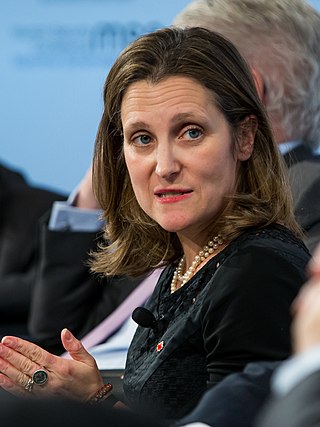
The prime minister of the United Kingdom is the head of government of the United Kingdom. The prime minister advises the sovereign on the exercise of much of the royal prerogative, chairs the Cabinet and selects its ministers. As modern prime ministers hold office by virtue of their ability to command the confidence of the House of Commons, they sit as members of Parliament. The current prime minister is Rishi Sunak of the Conservative Party, who assumed the office on 25 October 2022.

The deputy prime minister of the United Kingdom is the second highest ranking minister of the Crown and a member of the British Cabinet. The title is not always in use and prime ministers have been known to appoint informal deputies without the title of deputy prime minister. The incumbent deputy prime minister is Oliver Dowden who also serves as Chancellor of the Duchy of Lancaster and Secretary of State in the Cabinet Office.

The prime minister of Spain, officially president of the Government, is the head of government of Spain. The prime minister chairs the Council of Ministers and nominates its ministers; in these sense, the prime minister establishes the Government policies and coordinates the actions of the Cabinet members. As chief executive, the prime minister also advises the monarch on the exercise of their royal prerogatives.

The deputy prime minister of Canada is a minister of the Crown and a member of the Canadian Cabinet. The office is conferred at the discretion of the prime minister and does not have an associated departmental portfolio. Canadian deputy prime ministers are appointed to the Privy Council and styled as the Honourable, a privilege maintained for life.

The prime minister of Romania, officially the prime minister of the Government of Romania, is the head of the Government of Romania. Initially, the office was styled President of the Council of Ministers, when the term "Government" included more than the Cabinet, and the Cabinet was called the Council of Ministers. The title was officially changed to Prime Minister by the 1965 Constitution of Romania during the communist regime.

The prime minister of the Netherlands is the head of the executive branch of the Government of the Netherlands. Although the monarch is the de jure head of government, the prime minister de facto occupies this role as the officeholder chairs the Council of Ministers and coordinates its policy with the rest of the cabinet. In his role as head of government, the prime minister also represents the Netherlands in the European Council. The current acting prime minister, Mark Rutte, has been in the position since 14 October 2010, with his fourth cabinet being inaugurated on 10 January 2022. He resigned his position on 7 July 2023 and until a new prime minister is sworn in after the 2023 Dutch general election, he will serve in a demissionary capacity.

The deputy prime minister of New Zealand is the second-most senior member of the Cabinet of New Zealand. The officeholder usually deputises for the prime minister at official functions. The current deputy prime minister is Winston Peters of the NZ First party, who has held the position twice before, and will serve until 31 May 2025 due an arrangement under the current coalition government in which he would then be succeeded in the position by ACT party leader David Seymour.
A deputy prime minister or vice prime minister is, in some countries, a government minister who can take the position of acting prime minister when the prime minister is temporarily absent. The position is often likened to that of a vice president, as both positions are "number two" offices, but there are some differences.

The Prime Ministerof Vietnam, is the head of government of Vietnam who presides over the meetings of the Government. The prime minister directs the work of government members, and may propose deputy prime ministers to the National Assembly.

The deputy prime minister of Australia is the deputy chief executive and the second highest ranking officer of the Australian Government. The office of deputy prime minister was officially created as a ministerial portfolio in 1968, although the title had been used informally for many years previously. The deputy prime minister is appointed by the governor-general on the advice of the prime minister. When Australia has a Labor government, the deputy leader of the parliamentary party holds the position of deputy prime minister. When Australia has a Coalition government, the Coalition Agreement mandates that all Coalition members support the leader of the Liberal Party becoming prime minister and the leader of the National Party becoming the deputy prime minister.
The Union Council of Ministers is the principal executive organ of the Government of India, which functions as the senior decision-making body of the executive branch. It is chaired by the prime minister and consists of the heads of each of the executive government ministries. Currently, the council is headed by prime minister Narendra Modi and consists of 29 members, including the prime minister. The council is subject to the Parliament of India.

The deputy prime minister of Spain, officially vice president of the Government, is the second in command to the Prime Minister, assuming the responsibilities of the premiership when the prime minister is absent or incapable of exercising power.

The deputy prime minister of India, although not a Constitutional post, is the second-highest ranking minister of the Union in the executive branch of the Government of India and is a senior member of the Union Council of Ministers. The office holder also deputises for the prime minister in their absence.

The deputy prime minister of Malaysia is the second-highest political office in Malaysia. There have been 15 officeholders since the office was created in 1957. The first prime minister of Malaysia, Tunku Abdul Rahman, started the convention of appointing a deputy prime minister, but some cabinets have opted not to appoint a deputy prime minister.

The deputy prime minister of Singapore is the deputy head of government of the Republic of Singapore. The incumbent deputy prime ministers are Heng Swee Keat and Gan Kim Yong, who took office on 1 May 2019 and 15 May 2024 respectively.

The prime minister of Cambodia is the head of government of Cambodia. The prime minister is also the chairman of the Cabinet and leads the executive branch of the Royal Government of Cambodia. The prime minister is a member of parliament, and is appointed by the monarch for a term of five years. Since 1945, 37 individuals have served as prime minister; 33 as official prime ministers, and 4 in acting capacities. The current prime minister since 2023 is Hun Manet.

The deputy prime minister of Sweden is the deputy head of government of Sweden. The incumbent deputy prime minister is Ebba Busch.

The government of Russia is the federal executive body of state power of the Russian Federation. The members of the government are the prime minister, the deputy prime ministers, and the federal ministers. It has its legal basis in the Constitution of the Russian Federation and the federal constitutional law "On the Government of the Russian Federation". The Apparatus of the Government of Russia is a governmental body which administrates the activities of the government.

The Prime Minister of Saudi Arabia is the chairman of the Council of Ministers and head of government of the Kingdom of Saudi Arabia. The Prime Minister is always either the King of Saudi Arabia or Crown Prince of Saudi Arabia. Prince Mohammed bin Salman has been Prime Minister since 27 September 2022.
The deputy prime Minister of Japan is the second highest-ranking officer of the executive branch of the government of Japan after the prime minister of Japan, and ranks first in the line of succession to the prime minister. The office of the deputy prime minister is not a permanent position, and exists only at the discretion of the prime minister.
















